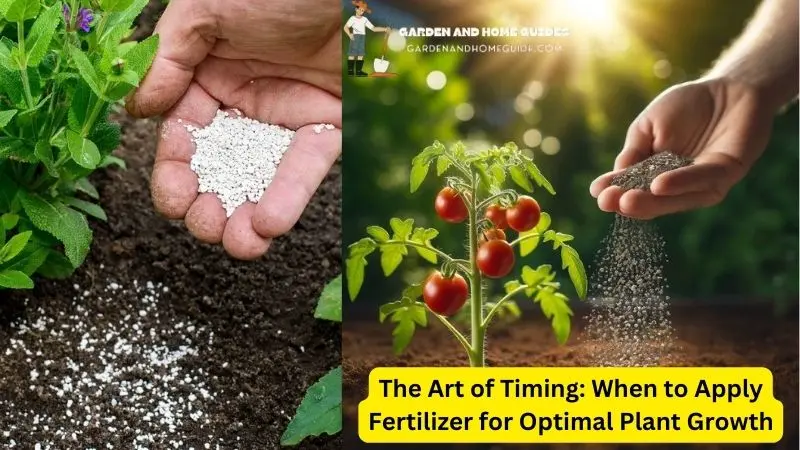Tree Care
When to Apply Fertilizer for Optimal Plant Growth?
Fertilizer, a vital nutrient supplement for plants, plays a crucial role in promoting healthy growth, vibrant blooms, and bountiful harvests. However, the effectiveness of fertilizer hinges significantly on the timing of its application. Applying fertilizer at the right moment maximizes its benefits and minimizes potential drawbacks, making it a critical aspect of successful gardening and agriculture.
This essay of Gardenandhomeguide.com delves into the intricacies of fertilizer application timing, exploring the factors influencing optimal application periods and highlighting the consequences of mistimed fertilization.
Understanding Plant Nutrient Needs:
Before delving into the specifics of application timing, it’s essential to understand the fundamental nutrient requirements of plants. Plants need a balanced supply of macronutrients (nitrogen, phosphorus, and potassium) and micronutrients (iron, zinc, manganese, etc.) for various functions. Nitrogen promotes leafy growth, phosphorus aids in root development and flowering, and potassium enhances disease resistance and overall vigor. Micronutrients play crucial roles in specific metabolic processes.
The timing of fertilizer application should align with the plant’s specific nutrient needs throughout its life cycle. For instance, young seedlings require a higher nitrogen content to support rapid growth, while flowering plants benefit from increased phosphorus levels. Understanding these needs allows for targeted fertilization strategies that maximize plant health and productivity.
Factors Influencing Fertilizer Application Timing:
Several factors influence the optimal timing for fertilizer application, each demanding careful consideration:
- Plant Species and Growth Stage: Different plant species have varying nutrient requirements and growth patterns. For example, fast-growing vegetables like lettuce require frequent fertilization, while slow-growing trees need less frequent applications. Similarly, plants in their vegetative growth stage (leaf production) need more nitrogen, while flowering and fruiting stages demand more phosphorus and potassium.
- Soil Type and Nutrient Availability: Soil type significantly affects nutrient availability. Sandy soils drain quickly, leading to rapid nutrient leaching, while clay soils retain nutrients but may have poor drainage. Each soil type requires a tailored fertilization schedule to ensure optimal nutrient uptake.
- Climate and Weather Conditions: Temperature, rainfall, and humidity influence nutrient availability and plant growth. High temperatures and heavy rainfall can leach nutrients from the soil, necessitating more frequent applications. Conversely, dry conditions may limit nutrient uptake, requiring adjustments in application timing.
- Fertilizer Type and Release Rate: Different fertilizer types have varying release rates. Fast-release fertilizers provide immediate nutrient availability but require frequent applications. Slow-release fertilizers release nutrients gradually over time, reducing the need for frequent applications. Choosing the right fertilizer type based on plant needs and environmental conditions is crucial.
When To Apply Fertilizer? Optimal Application Timing Strategies:
The optimal timing for fertilizer application is influenced by various factors such as plant type, soil condition, and climate. However, the following general guidelines can be useful for maximizing plant health and growth throughout the year:
Early Spring: This period is perfect for applying slow-release fertilizers to established plants. As the soil begins to warm up, nutrients become more accessible, encouraging robust and vigorous growth. This sets a strong foundation for the growing season ahead.
Mid-Spring to Early Summer: During this time, fast-release fertilizers are highly effective for plants that are actively growing, particularly those with high nitrogen needs. This ensures that plants receive the necessary nutrients to support rapid and healthy development during their peak growing phase.
Late Summer to Early Fall: This is the optimal time to apply phosphorus and potassium fertilizers. These nutrients help prepare plants for winter dormancy by promoting strong root development and enhancing the plant’s ability to withstand the colder months. This period is crucial for the overall health and resilience of the plants.
Fall or Early Winter: Fertilizing during this time can be beneficial for establishing new plantings and replenishing soil nutrients that may have been depleted during the growing season. This application helps to ensure that the soil remains fertile and supportive of plant growth when the new growing season begins.
Consequences of Mistimed Fertilization:
Applying fertilizer at the wrong time can have detrimental effects on plant health and productivity:
- Nutrient Imbalance: Applying fertilizers at inappropriate times can lead to nutrient imbalances, hindering plant growth and development. For example, excessive nitrogen application can promote leafy growth at the expense of flowering and fruiting.
- Nutrient Leaching: Heavy rainfall or irrigation after fertilizer application can leach nutrients from the soil, reducing their availability to plants.
- Salt Accumulation: Excessive fertilizer application can lead to salt accumulation in the soil, damaging plant roots and inhibiting growth.
- Environmental Pollution: Fertilizer runoff can contaminate water bodies, contributing to algal blooms and other environmental problems.
Conclusion:
Mastering the art of timing fertilizer application is crucial for maximizing plant growth and minimizing environmental impact. Understanding plant nutrient needs, soil type, climate conditions, and fertilizer types allows for tailored fertilization strategies that promote healthy and productive plants. By adhering to these guidelines and adapting them to specific circumstances, gardeners and farmers can ensure that their plants receive the right nutrients at the right time, reaping the rewards of optimal growth and bountiful harvests.






